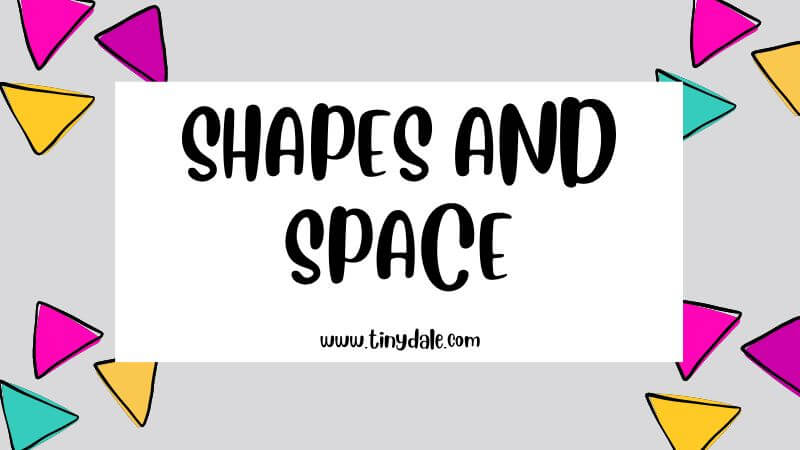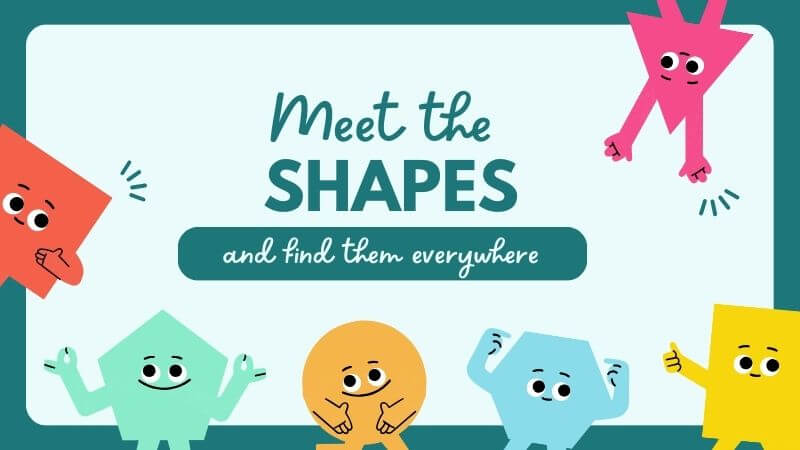Introducing young minds to the captivating world of shapes and space is a delightful endeavor. This article explores creative and engaging methods for effectively teaching shapes and space to class 1 students, setting them on a path of early educational success.
Shapes For Class 1 Students
- Square: A square is a four-sided shape with all sides of equal length. Examples include a window or a picture frame.
- Triangle: Teach them about triangles, which have three sides. A slice of pizza, a traffic sign, or a mountain’s peak can serve as visual examples.
- Rectangle: A rectangle has four sides with two pairs of opposite sides of equal length. Common objects include a book or a door.
- Oval: Oval shapes are elongated circles. Eggs, certain fruits, or an ellipse on a racetrack can be used to explain ovals.
- Diamond/Rhombus: Introduce the diamond or rhombus shape, which has four equal sides but isn’t a square. Playing cards or a kite are good visual examples.
- Heart: Although not a standard geometric shape, the heart is a recognizable shape for young students. Draw a heart and explain its symbolism.
- Star: Stars are fun and engaging shapes to teach. Use star stickers or drawings to help children recognize this shape.
- Crescent: The crescent is a moon-like shape that’s interesting for kids. Show them the moon during different phases to illustrate this.
- Hexagon: A hexagon has six sides. Bees’ honeycombs are a fantastic real-life example of this shape.
Space For Class 1 Students
- Outer Space:
- The Universe: Begin by explaining the term “universe.” Describe it as everything that exists, including stars, planets, and galaxies.
- The Solar System: Introduce our solar system, focusing on the Sun, the planets (especially Earth), and their order. Use visual aids like posters and models.
- The Moon: Discuss the moon and its connection to Earth. Talk about the phases of the moon and how it orbits our planet.
- Personal Space:
- Explaining Personal Space: Teach the concept of personal space, which is the area around each person that they feel comfortable with.
- Respect Boundaries: Discuss the importance of respecting personal space, especially when interacting with others.
- Role-Play: Engage in simple role-playing activities to help students understand and practice personal space in different social situations.
- Exploration:
- Astronomy: Share interesting facts about stars, constellations, and planets to spark their curiosity about space.
- Stargazing: If possible, arrange a stargazing session, either in a planetarium or during a clear night, to observe the night sky and identify basic constellations.
- Creative Activities:
- Art and Craft: Encourage students to create space-themed artwork, using materials like paper, paint, and glitter to craft stars, planets, and rockets.
- Storytelling: Share stories or books about space adventures to captivate their imaginations.
- Hands-On Learning:
- Science Experiments: Conduct simple experiments, like creating a model of the solar system with balls representing the planets.
- Model Rockets: If possible, consider building and launching small model rockets to demonstrate space exploration.
All About Shapes And Space
Children typically begin exploring shape and space concepts in their early years. They instinctively recognize basic shapes in their environment, like circles, squares, and triangles.
However, they need to learn the names of these shapes and their attributes, such as the number of sides and corners. Understanding 2D and 3D shapes, as well as their properties, is essential.
Children also need to grasp spatial relationships, including position, size, and orientation. This foundational knowledge forms the basis for geometry and spatial reasoning as they progress through their educational journey.
Hands-on activities, visual aids, and interactive experiences are crucial for effective learning in these areas. Source
10 Ways To Teach Shapes And Space
Teaching shapes and space to first-grade students can be a fun and engaging experience. Here are 10 easy and creative ways to teach these concepts to Class 1 students:
- Use Visual Aids: Incorporate visual aids such as posters, flashcards, and educational videos to introduce basic shapes (circle, square, triangle, rectangle) and explain concepts like 2D and 3D shapes.
- Storytelling: Craft simple stories that revolve around shapes and space. For example, tell a story about a square house with a triangular roof.
- Shape Hunts: Organize shape hunts in the classroom or schoolyard. Provide students with a list of shapes they need to find and identify in their surroundings.
- Art and Craft: Engage students in hands-on activities like cutting and pasting to create shape-based art. Encourage them to make collages using different shapes.
- Interactive Games: Incorporate shape-based games like Bingo or “I Spy” to make learning interactive and enjoyable. These games help reinforce shape recognition.
- Outdoor Learning: Take your class outside and explore the environment. Look for shapes in nature like the round sun, square windows, and triangular leaves.
- Building with Blocks: Use building blocks to teach about 3D shapes. Have students build structures with cubes, spheres, and cylinders.
- Interactive Apps: Utilize educational apps and websites designed for young children that focus on shapes and space. There are many interactive and engaging options available.
- Real-life Examples: Show students how shapes are used in everyday objects. For instance, explain how a pizza is a circle, a book is a rectangle, and a stop sign is an octagon.
- Group Activities: Organize group activities like sorting objects based on their shapes or creating collaborative shape-based art projects. Source
Free Shapes And Space Video
Summary!
Investing in interactive, hands-on activities and fostering a love for learning shapes and space to Class 1 kids is the key to their future educational journey. By making lessons fun and engaging, we inspire young minds and build a strong foundation for their academic growth.
Also Read: 10 Ways To Teach Data Handling To Kids!
Tinydale is on YouTube, Click here to subscribe for the latest videos and updates.
Follow Us: Facebook | Instagram | Twitter | Youtube | Pinterest


